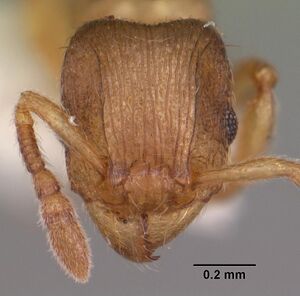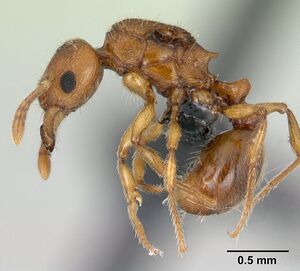Tetramorium cognatum
| Tetramorium cognatum | |
|---|---|

| |
| Scientific classification | |
| Kingdom: | Animalia |
| Phylum: | Arthropoda |
| Class: | Insecta |
| Order: | Hymenoptera |
| Family: | Formicidae |
| Subfamily: | Myrmicinae |
| Tribe: | Crematogastrini |
| Genus: | Tetramorium |
| Species group: | schaufussii |
| Species complex: | cognatum |
| Species: | T. cognatum |
| Binomial name | |
| Tetramorium cognatum Bolton, 1979 | |
The species was mostly collected from leaf litter and the ground.
Identification
A member of the Tetramorium cognatum species complex of the Tetramorium schaufussii species group. Hita Garcia and Fisher (2014) - Tetramorium cognatum can be easily separated from the other members of the T. cognatum species group by the following character combination: eyes very large (OI 27–29); antennal scapes very short (SI 61–67); frontal carinae weakly developed; propodeal spines reduced to very short, triangular teeth (PSLI 12–16), spines and lobes usually of approximately same length, often spines weakly shorter than lobes, very rarely spines weakly longer than lobes, never strongly directed towards each other; petiolar node high nodiform, in profile around 1.8 to 2.0 times higher than long (LPeI 49–55), in dorsal view around 1.3 to 1.4 times wider than long (DPeI 129–142); dorsal mesosoma normally with four to six (sometimes reduced to two to three) pairs of long, standing hairs occurring from anterior pronotum to metanotal groove, but absent from propodeum.
Tetramorium cognatum is an important species within this species complex. It is very widely distributed and common, and co-occurs in sympatry with almost all other members of the complex. It is easily distinguishable from the usually larger Tetramorium freya, which also lacks pilosity on the dorsal mesosoma, and Tetramorium gladius, the species with the smallest eyes in the complex (OI 19–20). Furthermore, T. cognatum possesses relatively weakly developed frontal carinae, separating it from Tetramorium myrmidon, Tetramorium proximum, and Tetramorium tenuinode. This character allies T. cognatum with Tetramorium aspis, Tetramorium camelliae, Tetramorium karthala, and Tetramorium rumo, to which it is generally closer in morphology. Of these species close to T. cognatum, T. karthala (endemic to Grand Comore) has longer antennal scapes (SI 70–74) and propodeal spines (PSLI 20–22) than T. cognatum (SI 61–67; PSLI 12–16). Tetramorium camelliae, only found in Ranomafana, and T. rumo have squamiform or thinly cuneiform petiolar nodes, which in profile are between 2.3 to 3.0 times higher than long (LPeI 33–43) while the node of T. cognatum is only 1.8 to 2.0 times higher than long (LPeI 49–55). Tetramorium aspis, which is only found in the area around Andringitra and Ivohibe, has longer propodeal spines (PSLI 18–21) than T. cognatum. More importantly however, the propodeal spines and lobes of T. cognatum are not strongly inclined towards each other as they are in T. aspis.
Considering its local abundance, relative flexibility in habitat requirements, and widespread distribution, T. cognatum shows startlingly little intraspecific variation. From the southern spiny forest Lavanono and the montane rainforests in Andohahela to the northernmost known localities at Montagne d’Ambre/Sakaramy, T. cognatum is always easily recognisable. However, some noticeable variation in sculpture and body colouration still exists. Colouration ranges from very light yellow through all shades of yellowish orange or brown to very dark brown, almost black. The southeastern and northern populations are mostly light yellow to light brown while most material from the central-eastern populations is mainly brown to very dark brown. There is also some variation in the degree to which sculpture is developed on the clypeus and the sides of the head and mesosoma as outlined in the description above.
Keys including this Species
Distribution
Endemic to Madagascar, this ant is found in a wide range of habitats and has a broad distribution across the island.
Latitudinal Distribution Pattern
Latitudinal Range: -12.44114° to -25.45056°.
| North Temperate |
North Subtropical |
Tropical | South Subtropical |
South Temperate |
- Source: AntMaps
Distribution based on Regional Taxon Lists
Afrotropical Region: Comoros.
Malagasy Region: Madagascar (type locality).
Distribution based on AntMaps
Distribution based on AntWeb specimens
Check data from AntWeb
Countries Occupied
| Number of countries occupied by this species based on AntWiki Regional Taxon Lists. In general, fewer countries occupied indicates a narrower range, while more countries indicates a more widespread species. |

|
Estimated Abundance
| Relative abundance based on number of AntMaps records per species (this species within the purple bar). Fewer records (to the left) indicates a less abundant/encountered species while more records (to the right) indicates more abundant/encountered species. |

|
Habitat
This species is one of the most common Tetramorium encountered in the rainforests and montane rainforests of Madagascar. Its distribution range encompasses almost all sampled forests in eastern and northern Madagascar, as well as the isolated humid forests in central and western parts of the island (e.g. Ambohijanahary, Isalo). Surprisingly, T. cognatum also seems to do fairly well outside humid forests since it is also found in a few disturbed gallery forests, in Uapaca woodland and tropical dry forests, and very rarely in spiny forest/thicket and savannah/grassland. Additional sampling in arid habitats might show that T. cognatum is even more widely distributed than currently understood. (Hita Garcia and Fisher 2014)
Biology
Castes
Images from AntWeb
  
| |
| Paratype of Tetramorium cognatum. Worker. Specimen code casent0102344. Photographer April Nobile, uploaded by California Academy of Sciences. | Owned by NHMUK, London, UK. |
   
| |
| Queen (alate/dealate). Specimen code casent0136756. Photographer Erin Prado, uploaded by California Academy of Sciences. | Owned by CAS, San Francisco, CA, USA. |
   
| |
| Paratype of Tetramorium karthala. Worker. Specimen code casent0136774. Photographer Erin Prado, uploaded by California Academy of Sciences. | Owned by NHMUK, London, UK. |
Nomenclature
The following information is derived from Barry Bolton's Online Catalogue of the Ants of the World.
- cognatum. Tetramorium cognatum Bolton, 1979: 135, figs. 1, 2 (w.q.) MADAGASCAR.
Unless otherwise noted the text for the remainder of this section is reported from the publication that includes the original description.
Description
Worker
Hita Garcia and Fisher (2014) - (N=25). HL 0.53–0.61 (0.57); HW 0.48–0.54 (0.51); SL 0.31–0.36 (0.33); EL 0.13–0.15 (0.14); PH 0.25–0.29 (0.27); PW 0.37–0.42 (0.39); WL 0.65–0.75 (0.70); PSL 0.07–0.10 (0.08); PTL 0.11–0.13 (0.12); PTH 0.21–0.25 (0.23); PTW 0.15–0.17 (0.16); PPL 0.14–0.16 (0.15); PPH 0.20–0.23 (0.21); PPW 0.20–0.23 (0.22); CI 87–91 (90); SI 61–67 (65); OI 27–29 (28); DMI 54–59 (56); LMI 36–40 (38); PSLI 12–16 (14); PeNI 38–44 (41); LPeI 49–55 (52); DPeI 129–142 (135); PpNI 53–59 (56); LPpI 66–75 (70); DPpI 137–153 (145); PPI 131–147 (137).
Head much longer than wide (CI 87–91); in full-face view posterior head margin usually very weakly concave. Anterior clypeal margin with distinct median impression. Frontal carinae weakly developed, only faintly raised, slightly diverging posteriorly, and relatively long, often ending shortly before posterior head margin. Antennal scrobes very weakly developed, shallow and without clear and distinct posterior and ventral margins. Antennal scapes very short, not reaching posterior head margin (SI 61–67). Eyes very large (OI 27–29). Mesosomal outline in profile flat to weakly convex, comparatively low and long (LMI 36–40), moderately marginate from lateral to dorsal mesosoma; promesonotal suture absent; metanotal groove usually present, but relatively weak. Propodeal spines reduced to very short, triangular teeth (PSLI 12–16), propodeal lobes short and triangular, spines and lobes usually of approximately same length, often spines weakly shorter than lobes, very rarely spines weakly longer than lobes. Petiolar node in profile rounded high nodiform, around 1.8 to 2.0 times higher than long (LPeI 49–55), anterior and posterior faces approximately parallel, anterodorsal margin usually sharper than more rounded posterodorsal margin, both margins often situated at about same height, often anterodorsal margin slightly higher, petiolar dorsum usually weakly convex; node in dorsal view around 1.3 to 2 times wider than long (DPeI 129–142), in dorsal view pronotum between 2.3 to 2.7 times wider than petiolar node (PeNI 38–44). Postpetiole in profile globular, rarely subglobular, between 1.3 to 1.5 times higher than long (LPpI 66–75); in dorsal view around 1.3 to 1.5 times wider than long (DPpI 137–153), pronotum between 1.7 to 1.9 times wider than postpetiole (PpNI 53–59). Postpetiole in profile usually appearing shorter and less voluminous than petiolar node, postpetiole in dorsal view between 1.3 to 1.5 times wider than petiolar node (PPI 131–147). Mandibles completely unsculptured, smooth, and shiny; clypeus usually irregularly longitudinally rugulose, median ruga often unbroken and well developed, often partly reduced, and often fully absent; lateral rugulae ranging from one to three on each side, often irregularly shaped, broken, or reduced to traces; cephalic dorsum between frontal carinae longitudinally rugulose with six to ten fine rugulae, rugulae usually running from posterior clypeal margin to posterior head margin, mostly irregularly shaped, interrupted, meandering or with cross-meshes, and sometimes becoming much weaker posteriorly; scrobal area mostly unsculptured, merging with surrounding sculpture; lateral head reticulate-rugose to longitudinally rugose, often with larger areas of reduced sculpture; ground sculpture on head weakly to moderately punctate, sometimes completely absent. Dorsum of mesosoma irregularly longitudinally rugulose, sometimes weakly so; lateral mesosoma usually mostly irregularly longitudinally rugulose, lateral pronotum often much weaker-sculptured, almost smooth, and sometimes reticulate-rugulose; ground sculpture on mesosoma usually weakly to moderately punctate, sometimes completely absent. Forecoxae usually unsculptured, smooth and shining, sometimes with traces of ground sculpture dorsally. Both waist segments and gaster fully unsculptured, smooth, and shining. Dorsum of head with several pairs of long, standing hairs, dorsal mesosoma normally with four to six (sometimes reduced to two to three) pairs occurring from anterior pronotum to metanotal groove, but absent from propodeum; waist segments and first gastral tergite without any long, standing hairs at all; first gastral tergite with moderately long, dense, appressed to decumbent pubescence. Anterior edges of antennal scapes and dorsal (outer) surfaces of hind tibiae with appressed to subdecumbent hairs. Body colouration variable, ranging from uniformly bright yellow to very dark brown, if colour brown to dark brown, appendages usually lighter.
Type Material
Hita Garcia and Fisher (2014) - Holotype, pinned worker, MADAGASCAR, Toamasina, Perinet & vicinity, 18.82667°S, 48.44778°E, rainforest, rotten wood, 19.III.1969 (W.L. Brown) (Museum of Comparative Zoology: MCZ_Holotype_32261) [examined]. Paratypes, eleven pinned workers with same data as holotype except collected from 17.–19.III.1969 (The Natural History Museum: CASENT0102343, CASENT0102344, CASENT0235218; MCZ: MCZ_Paratype_32261; Naturhistorisches Museum, Basel; Musee d'Histoire Naturelle Genève: CASENT0911248) [all examined, except NHMB].
[Note: the GPS data of the type locality was not provided either by the locality label or the original description. The data presented above is based on our own georeferencing of the Périnet=Andasibe area and should be considered an approximation and not the exact position of the type locality.]
References
- Bolton, B. 1979. The ant tribe Tetramoriini (Hymenoptera: Formicidae). The genus Tetramorium Mayr in the Malagasy region and in the New World. Bull. Br. Mus. (Nat. Hist.) Entomol. 38: 129-181.
- Hita Garcia, F. & Fisher, B.L. 2014. The hyper-diverse ant genus Tetramorium Mayr (Hymenoptera, Formicidae) in the Malagasy region ‑ taxonomic revision of the T. naganum, T. plesiarum, T. schaufussii, and T. severini species groups. ZooKeys 413, 1–170 (doi: 10.3897/zookeys.413.7172).
References based on Global Ant Biodiversity Informatics
- Bolton B. 1979. The ant tribe Tetramoriini (Hymenoptera: Formicidae). The genus Tetramorium Mayr in the Malagasy region and in the New World. Bulletin of the British Museum (Natural History). Entomology 38:129-181.
- Fisher B. L. 1996. Ant diversity patterns along an elevational gradient in the Réserve Naturelle Intégrale d'Andringitra, Madagascar. Fieldiana Zoology (n.s.)85: 93-108
- Fisher B. L. 1997. Biogeography and ecology of the ant fauna of Madagascar (Hymenoptera: Formicidae). Journal of Natural History 31: 269-302.
- Fisher B. L. 2003. Formicidae, ants. Pp. 811-819 in: Goodman, S. M.; Benstead, J. P. (eds.) 2003. The natural history of Madagascar. Chicago: University of Chicago Press, xxi + 1709 pp.
- Hita Garcia F, and B. L. Fisher. 2014. The hyper-diverse ant genus Tetramorium Mayr (Hymenoptera, Formicidae) in the Malagasy region - taxonomic revision of the T. naganum, T. plesiarum, T. schaufussii, and T. severini species groups. ZooKeys 413: 1-170.

